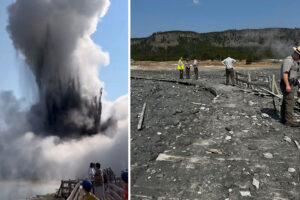Reports of flashing blue lights near Agadir, Morocco during the major earthquake that wracked the city earlier this month has refocused attention on a long-pondered phenomenon.
What are “earthquake lights?” They’ve been around for centuries, but we still don’t know. Broad speculation and ongoing study, facilitated especially by smartphone footage, resulted from the recent event.
Early articles on the Morocco earthquake lights, or EQLs, sought to dispel the (maybe predictable) theory that UFOs or UAPs caused them. Misinformation hazards occurred.
Prolific efforts at scientific explanation were next. In footage captured shortly before the 6.8 magnitude struck Morocco, killing 2,800 according to the latest estimates, blue lights flicker in the night sky.
Like switching on a battery
Sudden discharges of electricity are byproducts of fracturing rocks, scientists point out.
“Prior to earthquakes, huge volumes of rock — hundreds of thousands of cubic kilometers of rocks in the Earth’s crust — are being stressed and the stresses are causing shifting of the grain, the mineral grains relative (to) each other,” Friedemann Freund, a prominent EQL researcher, told CNN.
“It’s like switching on a battery, generating electrical charges that can flow out of the stressed rocks into and through unstressed rocks. The charges travel fast, at up to around 200 meters per second,” he explained in a 2014 article for The Conversation.
Freund’s claims amount to theorizing. Seismologists have not reached a consensus on the mechanism that causes these lights — only that, as retired U.S. Geological Survey geophysicist John Derr told CNN, they are “definitely real.”
Reports date back to the 1600s
A 2014 paper by Derr and a group of colleagues traced the lights to a relatively rare type of earthquake. Instead of occurring near tectonic plate boundaries, like most earthquake events, the lights tend to appear in association with tremors that take place far from plate boundaries.
“Intraplate faults are associated with just 5 percent of Earth’s seismic activity, but 97 percent of documented cases of earthquake lights,” said a press release issued in conjunction with the study.
The research looked at 65 documented cases dating back to the 1600s.
Another common factor it identified among EQL was earthquakes greater than 5.0 in magnitude. It also described the typical appearance of EQL.
“The EQL varied in shape and extent, though most commonly appeared as globular luminous masses, either stationary or moving, as atmospheric illuminations or as flame-like luminosities issuing from the ground,” according to the release.
Robert Theriault, a geologist with Quebec, Canada’s Ministry of Natural Resources, co-authored the study. He thinks EQL could hold keys to the future of predicting earthquake events.
“Earthquake lights as a pre-earthquake phenomenon, in combination with other types of parameters that vary prior to seismic activity, may one day help forecast the approach of a major quake,” he said.






